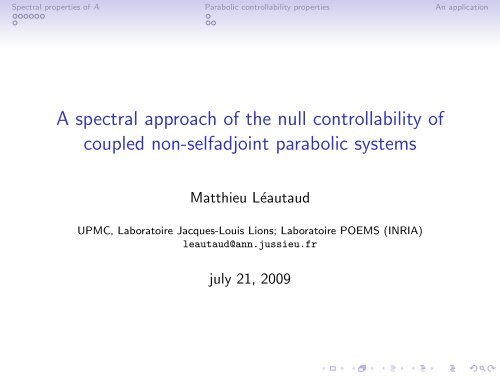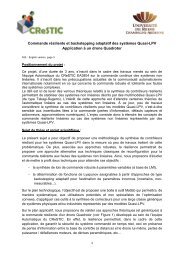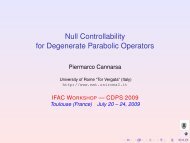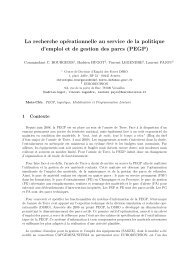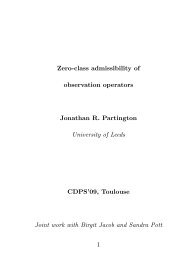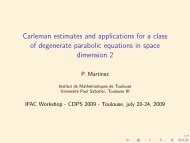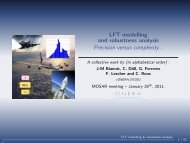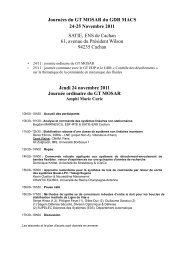A spectral approach of the null controllability of coupled non ...
A spectral approach of the null controllability of coupled non ...
A spectral approach of the null controllability of coupled non ...
You also want an ePaper? Increase the reach of your titles
YUMPU automatically turns print PDFs into web optimized ePapers that Google loves.
Spectral properties <strong>of</strong> A Parabolic <strong>controllability</strong> properties An applicationA <strong>spectral</strong> <strong>approach</strong> <strong>of</strong> <strong>the</strong> <strong>null</strong> <strong>controllability</strong> <strong>of</strong><strong>coupled</strong> <strong>non</strong>-selfadjoint parabolic systemsMatthieu LéautaudUPMC, Laboratoire Jacques-Louis Lions; Laboratoire POEMS (INRIA)leautaud@ann.jussieu.frjuly 21, 2009
Spectral properties <strong>of</strong> A Parabolic <strong>controllability</strong> properties An applicationThe <strong>null</strong>-<strong>controllability</strong> problem{∂t u + Au = Bgu |t=0 = u 0(1)• A elliptic• B boundedQuestion: for a fixed T > 0, ∃? a control function g s.t.u |t=T = 0?
Spectral properties <strong>of</strong> A Parabolic <strong>controllability</strong> properties An applicationThe <strong>null</strong>-<strong>controllability</strong> problem{∂t u + Au = Bgu |t=0 = u 0(1)• A elliptic• B boundedQuestion: for a fixed T > 0, ∃? a control function g s.t.u |t=T = 0?• Scalar parabolic equations: A = −∆ + b · ∇ + c and B = 1( ) ( ) ωu1 −∆ + a b• Parabolic systems: u = A =,u 2 c −∆ + d( ) 0B =1 ω
Spectral properties <strong>of</strong> A Parabolic <strong>controllability</strong> properties An applicationTwo different <strong>approach</strong>es for scalar parabolic equations• Lebeau-Robbiano ’95A = −∆, selfadjoint !local elliptic Carleman estimates; <strong>spectral</strong> method• Fursikov-Imanuvilov ’96A = −∆ + b(x, t) · ∇ + c(x, t)global parabolic Carleman estimates
Spectral properties <strong>of</strong> A Parabolic <strong>controllability</strong> properties An applicationAdvantages <strong>of</strong> <strong>the</strong> Lebeau-Robbiano methodThis method• only relies on elliptic Carleman estimates → simpler toproduce• enlights some fundamental properties <strong>of</strong> <strong>the</strong> elliptic operatorA: <strong>spectral</strong> inequality (Lebeau-Zuazua ’98, Jerison-Lebeau’99)• yields <strong>the</strong> cost <strong>of</strong> <strong>the</strong> <strong>null</strong>-<strong>controllability</strong> <strong>of</strong> <strong>the</strong> low frequencies<strong>of</strong> <strong>the</strong> elliptic operator A• gives an explicit iterative construction <strong>of</strong> <strong>the</strong> control function
Spectral properties <strong>of</strong> A Parabolic <strong>controllability</strong> properties An applicationOutlineSpectral properties <strong>of</strong> ASpectral <strong>the</strong>ory <strong>of</strong> perturbed selfadjoint operators ASpectral inequality for AParabolic <strong>controllability</strong> propertiesPartial controlFinal controlAn application
Spectral properties <strong>of</strong> A Parabolic <strong>controllability</strong> properties An applicationSpectral properties <strong>of</strong> A: localization <strong>of</strong> <strong>the</strong> spectrumPropositionLet A = A 0 + A 1 be an operator on H. Assume that(a) Re(Au, u) H ≥ λ 0 ‖u‖ 2 Hfor all u ∈ D(A),(b) A 0 : D(A 0 ) ⊂ H → H is selfadjoint, positive, with a densedomain and compact resolvent,(c) A 1 : D(A 1 ) ⊂ H → H satisfies|(A 1 u, u) H | ≤ C‖A 1/20u‖ 2qH ‖u‖2−2q Hfor q ∈ [0, 1)
Spectral properties <strong>of</strong> A Parabolic <strong>controllability</strong> properties An applicationSpectral properties <strong>of</strong> A: localization <strong>of</strong> <strong>the</strong> spectrumPropositionLet A = A 0 + A 1 be an operator on H. Assume that(a) Re(Au, u) H ≥ λ 0 ‖u‖ 2 Hfor all u ∈ D(A),(b) A 0 : D(A 0 ) ⊂ H → H is selfadjoint, positive, with a densedomain and compact resolvent,(c) A 1 : D(A 1 ) ⊂ H → H satisfies|(A 1 u, u) H | ≤ C‖A 1/20u‖ 2qH ‖u‖2−2q Hfor q ∈ [0, 1)We <strong>the</strong>n have,(i) D(A) = D(A 0 ) ⊂ D(A 1 ) ⊂ H and A has a dense domain anda compact resolvent,(ii) Sp(A) ⊂ P q K 0= {z ∈ C, Re(z) ≥ 0, | Im(z)| < K 0 Re(z) q }(iii) ‖R A (z)‖ L(H) ≤2d(z,Sp(A 0 )) ≤ 2d(z,R +) for z ∈ C \ Pq K 0,
Spectral properties <strong>of</strong> A Parabolic <strong>controllability</strong> properties An applicationSpectral properties <strong>of</strong> A: localization <strong>of</strong> <strong>the</strong> spectrumIm(z) ∂P q K 0λ 0Re(z)Figure: Localization <strong>of</strong> <strong>the</strong> spectrum <strong>of</strong> A
Spectral properties <strong>of</strong> A Parabolic <strong>controllability</strong> properties An applicationSpectral properties <strong>of</strong> A: resolvent estimateTheorem (Markus, Katsnel’son, Matsaev, Agranovich,Dzhanlatyan... 1970-2000...)Let 0 < λ 1 ≤ λ 2 ≤ · · · ≤ λ k ≤ · · · be <strong>the</strong> spectrum <strong>of</strong> A 0(selfadjoint). Suppose that ∃p > 0 s.t. lim sup j→∞ λ j j −p > 0.Then, setting β = max{0, p −1 − (1 − q)} <strong>the</strong>re exists a sequence0 < α 0 ≤ α 1 ≤ · · · ≤ α k ≤ · · · → ∞ such that‖R A (z)‖ L(H) ≤ e Cα k β , k ∈ N, Re(z) = α k . (2)Example:If A = −∆ + b · ∇ + c, <strong>the</strong>n q = 1/2, p = 2/n (Weyl). Thusβ = max{0, (n − 1)/2}
Spectral properties <strong>of</strong> A Parabolic <strong>controllability</strong> properties An applicationSpectral properties <strong>of</strong> A: resolvent estimateIm(z) ∂P q K 0Re(z)α 0 λ 0 α 1α k−1α kFigure: Resolvent estimate A
Spectral properties <strong>of</strong> A Parabolic <strong>controllability</strong> properties An applicationSpectral projectors <strong>of</strong> ADefinitionSpectral projectorsΠ α = 1 ∫R A (z)dz,2iπ Γ αand Π ∗ α its adjointHolomorphic calculus on Π α H:‖f (A)Π α ‖ L(H) = 1∫2π ∥ f (z)R A (z)dz∥ ≤ Cαe Cαβ sup |f (z)|Γ α L(H) z∈Γ α
Spectral properties <strong>of</strong> A Parabolic <strong>controllability</strong> properties An applicationSpectral properties <strong>of</strong> A: <strong>spectral</strong> projectorsIm(z) ∂P q K 0Re(z)αα 0α 1λ 0Γ αα k−1 α kFigure: Complex contours around <strong>the</strong> spectrum <strong>of</strong> A
Spectral properties <strong>of</strong> A Parabolic <strong>controllability</strong> properties An applicationSpectral inequality for ANotation:• H = state space; Y = observation (control) space• B ∗ ∈ L(H, Y ) a bounded observation operator• θ = max{1/2, p −1 − (1 − q)}
Spectral properties <strong>of</strong> A Parabolic <strong>controllability</strong> properties An applicationNotation:Spectral inequality for A• H = state space; Y = observation (control) space• B ∗ ∈ L(H, Y ) a bounded observation operator• θ = max{1/2, p −1 − (1 − q)}TheoremSuppose that ∀v ∈ H 2 (0, T 0 ) satisfying v(0) = 0, we have forsome ν ∈ (0, 1]‖v‖ H 1 (ζ,T 0 −ζ) ≤ C‖v‖ 1−νH 1 (0,T 0 )(‖B ∗ ∂ t v(0)‖ Y + ‖(−∂ 2 t + A ∗ )v‖ H 0 (0,T 0 )) ν.Then, ∃C, D > 0 such that ∀α > 0, ∀w ∈ Π ∗ αH,‖w‖ H ≤ Ce Dαθ ‖B ∗ w‖ Y.If A = −∆ + b · ∇ + c, <strong>the</strong>n θ = max{1/2, (n − 1)/2}
Spectral properties <strong>of</strong> A Parabolic <strong>controllability</strong> properties An applicationFind g α s.t.⎧⎨⎩Partial control on Π α H∂ t u + Au = Π α Bg αu |t=0 = u 0 ∈ Π α Hu |t=T = 0Theorem∀T > 0, ∃g α ∈ L 2 (0, T ; Y ) driving u 0 to 0 in time T with a costgiven by ‖g α ‖ L 2 (0,T ;Y ) ≤ CT −1/2 e Dαθ ‖u 0 ‖ H .
Spectral properties <strong>of</strong> A Parabolic <strong>controllability</strong> properties An applicationFind g α s.t.⎧⎨⎩Partial control on Π α H∂ t u + Au = Π α Bg αu |t=0 = u 0 ∈ Π α Hu |t=T = 0Theorem∀T > 0, ∃g α ∈ L 2 (0, T ; Y ) driving u 0 to 0 in time T with a costgiven by ‖g α ‖ L 2 (0,T ;Y ) ≤ CT −1/2 e Dαθ ‖u 0 ‖ H .Pro<strong>of</strong>. { −∂t w + AAdjoint system:∗ w = 0w |t=T = w T ∈ Π ∗ αH.Observation inequality (<strong>spectral</strong> inequality):∫ T∫ TT ‖w(0)‖ 2 H ≤ ‖w(t)‖ 2 H dt ≤ C 2 e 2Dαθ ‖B ∗ w(t)‖ 2 Y dt00
Spectral properties <strong>of</strong> A Parabolic <strong>controllability</strong> properties An applicationFinal controlTheoremSuppose that θ < 1. Then, for every T > 0, u 0 ∈ H, <strong>the</strong>re exists acontrol function g ∈ L 2 (0, T ; Y ) such that <strong>the</strong> solution u <strong>of</strong> <strong>the</strong>problem{∂t u + Au = Bg,satisfies u(T ) = 0.u |t=0 = u 0 ∈ H,
Spectral properties <strong>of</strong> A Parabolic <strong>controllability</strong> properties An applicationFinal controlTheoremSuppose that θ < 1. Then, for every T > 0, u 0 ∈ H, <strong>the</strong>re exists acontrol function g ∈ L 2 (0, T ; Y ) such that <strong>the</strong> solution u <strong>of</strong> <strong>the</strong>problem{∂t u + Au = Bg,satisfies u(T ) = 0.u |t=0 = u 0 ∈ H,Idea <strong>of</strong> <strong>the</strong> pro<strong>of</strong> (Lebeau-Robbiano ’95): [0, T ] = ⋃ j∈N [a j, a j+1 ],a j+1 = a j + 2T j• if t ∈ (a j , a j + T j ]: g =partial control → cost e Dαθ j• if t ∈ (a j + T j , a j+1 ]: g = 0, parabolic dissipation e −Cα j
Spectral properties <strong>of</strong> A Parabolic <strong>controllability</strong> properties An applicationFinal controlIm(z) ∂P q K 0Re(z)αα 0α 1λ 0Γ αα k−1 α kFigure: Elimination and dissipation
Spectral properties <strong>of</strong> A Parabolic <strong>controllability</strong> properties An applicationApplication to parabolic systems⎧⎪⎨⎪⎩• A =∂ t u 1 − ∆u 1 + au 1 + bu 2 = 0 in (0, T ) × Ω,∂ t u 2 − ∆u 2 + cu 1 + du 2 = 1 ω g in (0, T ) × Ω,u 1|t=0 = u1 0 , u 2|t=0 = u2 0 in Ω,u 1 = u 2 = 0on (0, T ) × ∂Ω,( −∆ 00 −∆) ( a b+c d) ( ) 0, B =1 ω• p = n/2, q = 0, and θ = max{1/2; n/2 − 1}(θ < 1 ⇔ n ≤ 3)
Spectral properties <strong>of</strong> A Parabolic <strong>controllability</strong> properties An applicationApplication to parabolic systemsPropositionSuppose |b(x)| ≥ b 0 > 0 on O and O ∩ ω ≠ ∅Then, ∃C > 0, ϕ ∈ C ∞ 0 (0, T 0) and ν ∈ (0, 1) such that∀v ∈ ( H 2 ((0, T 0 ) × Ω) ) 2 , v|(0,T0 )×∂Ω = 0, we have‖v‖ (H 1 ((ζ,T 0 −ζ)×Ω)) 2 ≤ C‖v‖1−ν (H 1 ((0,T 0 )×Ω)) 2(‖ϕB ∗ v‖ L 2 (Ω) + ‖(−∂ 2 t + A ∗ )v‖ (L 2 ((0,T 0 )×Ω)) 2 ) ν.
Spectral properties <strong>of</strong> A Parabolic <strong>controllability</strong> properties An applicationApplication to parabolic systemsPropositionSuppose |b(x)| ≥ b 0 > 0 on O and O ∩ ω ≠ ∅Then, ∃C > 0, ϕ ∈ C ∞ 0 (0, T 0) and ν ∈ (0, 1) such that∀v ∈ ( H 2 ((0, T 0 ) × Ω) ) 2 , v|(0,T0 )×∂Ω = 0, we have‖v‖ (H 1 ((ζ,T 0 −ζ)×Ω)) 2 ≤ C‖v‖1−ν (H 1 ((0,T 0 )×Ω)) 2(‖ϕB ∗ v‖ L 2 (Ω) + ‖(−∂ 2 t + A ∗ )v‖ (L 2 ((0,T 0 )×Ω)) 2 ) ν.• A <strong>spectral</strong> inequality holds• The partial <strong>controllability</strong> result holds• In <strong>the</strong> case n ≤ 3, <strong>the</strong> <strong>controllability</strong> result holds
Spectral properties <strong>of</strong> A Parabolic <strong>controllability</strong> properties An applicationO<strong>the</strong>r applications...• Fractional parabolic equations{∂t u + A ν u = Bgu |t=0 = u 0 ∈ H.Null-controllable in any time T > 0 in <strong>the</strong> case ν > θ.• Nodal sets <strong>of</strong> sums <strong>of</strong> root functions <strong>of</strong>A = −∆ + b · ∇ + cThere exist positive constants C 1 , C 2 such that for all α > 0and ϕ ∈ Π α L 2 (Ω),{ 1H n−1 ({ϕ = 0}) ≤ C 1 α θ + C 2 , θ = max2 ; n − 1 }.2
Spectral properties <strong>of</strong> A Parabolic <strong>controllability</strong> properties An applicationConclusions and perspectivesConclusions:• Spectral inequalities for second order elliptic <strong>non</strong>-selfadjointoperators• Cost <strong>of</strong> <strong>the</strong> <strong>null</strong>-<strong>controllability</strong> <strong>of</strong> <strong>the</strong> low frequencies <strong>of</strong> <strong>the</strong>elliptic operator A• Applications to parabolic <strong>coupled</strong> systems, to nodal sets <strong>of</strong>sums <strong>of</strong> root functions <strong>of</strong> <strong>the</strong> elliptic operator APerspectives:• Improve θ ?• Boundary <strong>controllability</strong> for systems (elliptic estimates andconstruction <strong>of</strong> <strong>the</strong> control function)


